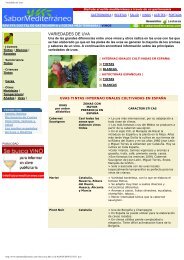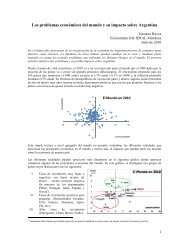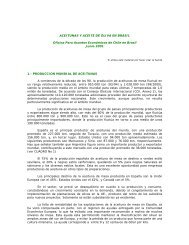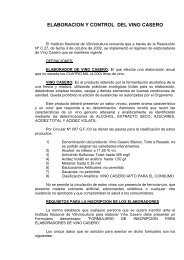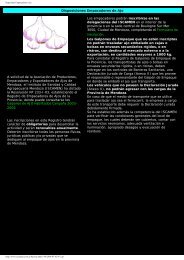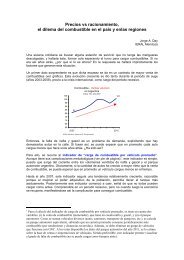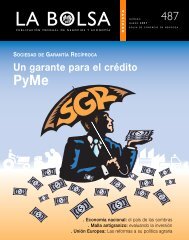mayo 08 - Bolsa de Comercio de Mendoza
mayo 08 - Bolsa de Comercio de Mendoza
mayo 08 - Bolsa de Comercio de Mendoza
Create successful ePaper yourself
Turn your PDF publications into a flip-book with our unique Google optimized e-Paper software.
LA BOLSA PUBLICACIÓN MENSUAL DE NEGOCIOS Y ECONOMÍA<br />
R<br />
EVISTA<br />
NÚMERO<br />
M AYO 20<strong>08</strong><br />
499<br />
BOLSA DE COMERCIO DE MENDOZA<br />
VIÑEDOS ARGENTINOS:<br />
Cantidad y calidad<br />
mirando a los mercados<br />
Promendoza: apuntalando el mercado norteamericano<br />
Informe económico: A punto <strong>de</strong> per<strong>de</strong>r otra oportunidad
LA BOLSA<br />
PUBLICACIÓN MENSUAL DE NEGOCIOS Y ECONOMÍA<br />
Mayo 20<strong>08</strong><br />
Propiedad intelectual N° 592601<br />
BOLSA DE COMERCIO DE MENDOZA<br />
Paseo Sarmiento y Avda. España<br />
CP 5500 - <strong>Mendoza</strong>. PBX 4496100<br />
cinformaciones@bolsamza.com.ar<br />
http//www.bolsamza.com.ar<br />
Director responsable:<br />
Alberto Díaz Telli<br />
Director periodístico:<br />
Gabriel Bustos Herrera<br />
Directorio <strong>de</strong> la<br />
<strong>Bolsa</strong> <strong>de</strong> <strong>Comercio</strong> <strong>de</strong> <strong>Mendoza</strong><br />
Presi<strong>de</strong>nte<br />
Alberto Díaz Telli<br />
Vicepresi<strong>de</strong>nte 1º<br />
Jorge Pérez Cuesta<br />
Vicepresi<strong>de</strong>nte 2º<br />
Miguel A. Labiano<br />
Secretario: Luis Alberto Ábrego<br />
Pro-Secretario: Roberto R. Gazali<br />
Tesorero: Rubén Darío Cano<br />
Pro-Tesorero: Luis Bonfiglio<br />
Vocales Titulares<br />
Jorge Baldrich, César Fracchia, Alberto<br />
Goyenechea, Alberto Lasmartres, Luis<br />
Latour, Carlos López Laurenz, Daniel<br />
Reig, Ricardo Stra<strong>de</strong>llla<br />
Síndicos Titulares: Juan Carlos Mari,<br />
Carlos Schestakow, Horacio Marchessi<br />
Gerente General: Betina Surballe<br />
Colaboraron en esta edición:<br />
Rodolfo Cavagnaro, Gabriela Quinteros,<br />
Adriana Muñiz, Claudia Zeballos, Carlos<br />
Palacio, Silvia Flores, M. Alba Rodríguez<br />
Pardo<br />
Fotos: Promendoza y <strong>de</strong> archivo <strong>Bolsa</strong><br />
<strong>de</strong> <strong>Comercio</strong>.<br />
Diagramación, fotocromía,<br />
preprensa digital, impresión y<br />
encua<strong>de</strong>rnación:<br />
INCA Editorial Coop. <strong>de</strong> Trabajo Ltda.<br />
José F. Moreno 2164/2188 M5500AXF<br />
<strong>Mendoza</strong>, Argentina.<br />
Tel./fax +54 0261 429 0409 / 425 9161<br />
e-mail: incasterio@incaeditorial.com<br />
Asuntos pendientes<br />
Disipadas las tensiones <strong>de</strong> la última cosecha y elaboración,<br />
mientras en los lagares ya madura el vino<br />
nuevo, ahora la vitivinicultura nacional vuelve a ocuparse<br />
<strong>de</strong> sus asuntos pendientes. Es el momento<br />
en que los observadores más meticulosos ponen la<br />
lupa sobre aquellos aspectos <strong>de</strong> la industria que están<br />
marcando algunas señales <strong>de</strong> preocupación. En<br />
este nuevo número <strong>de</strong> la revista "La <strong>Bolsa</strong>", incluimos<br />
un trabajo <strong>de</strong> investigación realizado por catedráticos<br />
mendocinos <strong>de</strong> la Facultad <strong>de</strong> Ciencias<br />
Agrarias <strong>de</strong> la UNC, don<strong>de</strong> reflejan la evolución <strong>de</strong> la<br />
superficie implantada y la cantidad <strong>de</strong> viñedos <strong>de</strong>s<strong>de</strong><br />
finales <strong>de</strong> la década <strong>de</strong>l ‘70 hasta la actualidad.<br />
Según los autores, en 28 años, se ha mejorado en<br />
cantidad y fundamentalmente en la calidad <strong>de</strong> nuestros<br />
viñedos, pero en este proceso, la gran contracción<br />
se ha dado en el estrato <strong>de</strong> menos <strong>de</strong> 10 hectáreas,<br />
don<strong>de</strong> se manifiesta una pérdida <strong>de</strong> 10.725<br />
viñedos, generalmente <strong>de</strong> propiedad <strong>de</strong> pequeños<br />
productores (representarían a unos 8.000 pequeños<br />
productores vitícolas que han <strong>de</strong>jado <strong>de</strong> participar<br />
directa o indirectamente en la actividad). Según los<br />
expertos, "el bajo nivel <strong>de</strong> competitividad <strong>de</strong>l país en<br />
el mercado externo y las continuas crisis económi-<br />
S U M A R I O<br />
Superficie<br />
vitícola argentina 4<br />
Un estudio realizado por<br />
profesionales <strong>de</strong> la UNCuyo<br />
afirma que los viñedos <strong>de</strong> más<br />
<strong>de</strong> 25 hectáreas, se han<br />
incrementado en un 15% y los<br />
<strong>de</strong> menos <strong>de</strong> 5 hectáreas han<br />
disminuido el 38% <strong>de</strong>s<strong>de</strong> la<br />
década <strong>de</strong>l `90 a la actualidad<br />
ca <strong>de</strong> nuestro país –registradas sobre el período <strong>de</strong><br />
análisis–, agravaron el problema <strong>de</strong> la caída <strong>de</strong>l consumo<br />
<strong>de</strong> vinos básicos (comunes), y fueron las causas<br />
<strong>de</strong> la gran disminución <strong>de</strong> la superficie vitícola<br />
Argentina. Este dato, se suma a uno más actual, sobre<br />
las advertencias <strong>de</strong> algunos actores económicos<br />
locales sobre los inconvenientes que se están presentando<br />
en la industria vitivinícola nacional que, a<br />
pesar <strong>de</strong> ser el sector que más avanzó –respecto <strong>de</strong><br />
las <strong>de</strong>más activida<strong>de</strong>s agroindustriales locales–,<br />
muestra un elevado e importante grado <strong>de</strong> "atraso<br />
tecnológico" en viñedos, así como en equipamiento<br />
y gestión <strong>de</strong> las bo<strong>de</strong>gas. Este panorama pue<strong>de</strong> incidir<br />
en el futuro, si el mercado interno y la <strong>de</strong>manda<br />
internacional continúan su avance -en volumen y calidad-<br />
y los empresarios <strong>de</strong>l sector no pue<strong>de</strong>n dar<br />
una pronta respuesta. "Mientras el consumo en el<br />
mundo aumenta, nuestra inversión instalada se <strong>de</strong>teriora<br />
y está llegando al límite", señalan los expertos.<br />
Algunas señales para tener en cuenta. Entonces,<br />
¿será capaz el sector <strong>de</strong> retomar en poco<br />
tiempo un ritmo <strong>de</strong> inversiones que le permita afrontar<br />
los compromisos nacionales e internacionales,<br />
sin per<strong>de</strong>r mercados?<br />
Expovinis 20<strong>08</strong>. . . . . . . . . . . . . . . . 8<br />
Promendoza: apuntalando el mercado<br />
norteamericano . . . . . . . . . . . . . . . 10<br />
Informe económico:<br />
A punto <strong>de</strong> per<strong>de</strong>r otra oportunidad 13<br />
Isabel Civit <strong>de</strong> Day con sus acuarelas en la <strong>Bolsa</strong>, pág. 15
4/ LA BOLSA<br />
Evolución<br />
<strong>de</strong> la superficie vitíco<br />
El presente trabajo ha sido<br />
elaborado a partir <strong>de</strong> datos e<br />
información recopilada para<br />
la redacción <strong>de</strong>l libro <strong>de</strong><br />
temática vitivinícola,<br />
"Reconfiguración <strong>de</strong> actores y<br />
transformaciones<br />
estructurales", presentado<br />
durante las IV Jornadas<br />
Interdisciplinarias <strong>de</strong> Estudios<br />
Agrarios y Agroindustriales<br />
realizadas en Buenos Aires<br />
durante noviembre <strong>de</strong> 2007<br />
por los autores: Adriana<br />
Bocco, Laura Alturria, José<br />
Gudiño, Jerónimo Oliva,<br />
Guillermo Salvarredi, Hernán<br />
Vila. La presente<br />
investigación, tien<strong>de</strong> a<br />
mostrar cómo ha<br />
evolucionando la superficie<br />
vitícola <strong>de</strong> nuestro país, a<br />
partir <strong>de</strong> fines <strong>de</strong> la década<br />
<strong>de</strong> los ‘70, hasta la<br />
actualidad.<br />
C<br />
ambios estructurales<br />
A partir <strong>de</strong> las estadísticas<br />
históricas <strong>de</strong>l Instituto Nacional<br />
<strong>de</strong> Vitivinicultura, se observa<br />
que la máxima superficie<br />
vitícola se registró en 1979 con<br />
316.355 hectáreas implantadas<br />
con 52.171 viñedos. Esta superficie<br />
respondía a una vitivinicultura<br />
nacional don<strong>de</strong> el consumidor<br />
<strong>de</strong>mandaba gran<strong>de</strong>s<br />
volúmenes <strong>de</strong> vino indiferencia-<br />
do. A partir <strong>de</strong> ese año, la superficie<br />
comienza a disminuir. A comienzos<br />
<strong>de</strong> la década <strong>de</strong> los 90,<br />
Argentina contaba con 210.371<br />
hectáreas implantadas, lo que representó<br />
una disminución <strong>de</strong>l<br />
33,5% respecto <strong>de</strong> 1979. Algo similar<br />
ocurrió con la cantidad <strong>de</strong><br />
viñedos, que bajó en un 30%.<br />
Durante esta época, la superficie<br />
media <strong>de</strong>l viñedo argentino era <strong>de</strong><br />
5,78 hectáreas.<br />
!La gran contracción se ha dado en el estrato <strong>de</strong> menos <strong>de</strong><br />
10 has don<strong>de</strong> se manifiesta una pérdida <strong>de</strong> 10.725<br />
viñedos, generalmente propiedad <strong>de</strong> pequeños productores.
la en Argentina<br />
Para fines <strong>de</strong> la década <strong>de</strong> los<br />
‘90 (1999-2000), continuó la<br />
caída <strong>de</strong> la superficie implantada<br />
en un 4,7%, pero como dato<br />
relevante, esta caída fue<br />
acompañada por una profunda<br />
transformación <strong>de</strong>l viñedo,<br />
orientado hacia la reconversión<br />
varietal, a<strong>de</strong>más <strong>de</strong> una fuerte<br />
disminución en la cantidad <strong>de</strong><br />
viñedos <strong>de</strong>ntro un contexto <strong>de</strong><br />
relativa estabilidad <strong>de</strong> la superficie<br />
cultivada. Este hecho resultó<br />
en el aumento <strong>de</strong>l tamaño<br />
promedio <strong>de</strong>l viñedo. Así durante<br />
1993, la superficie media pasó<br />
a ser <strong>de</strong> 6,09 hectáreas, para<br />
crecer hacia el 2000, a 7,99<br />
hectáreas.<br />
!<br />
La pequeña escala<br />
<strong>de</strong> superficie <strong>de</strong> la<br />
<strong>mayo</strong>ría <strong>de</strong> los viñedos<br />
agudiza los problemas <strong>de</strong><br />
rentabilidad en aquellas<br />
explotaciones con bajos<br />
volúmenes <strong>de</strong> producción.<br />
Hacia los últimos meses <strong>de</strong>l<br />
2000 y durante 4 años, la caída<br />
que se venía registrando en la<br />
cantidad <strong>de</strong> superficie implantada<br />
se estabiliza y con esto,<br />
comienza un crecimiento durante<br />
ese período en el or<strong>de</strong>n<br />
<strong>de</strong>l 4,6%. A<strong>de</strong>más, la cantidad<br />
Ing. Agr. Laura Alturria<br />
Cátedra <strong>de</strong> Administración Rural<br />
Facultad <strong>de</strong> Ciencias Agrarias. UNCuyo<br />
Evolución <strong>de</strong> superficie implantada y cantidad <strong>de</strong> viñedos:<br />
variación anual y evolución <strong>de</strong> superficie media <strong>de</strong>l viñedo<br />
Años Superficie Cantidad <strong>de</strong> Variación Sup. Media<br />
(ha) viñedos anual en: <strong>de</strong>l viñedo (has)<br />
1979 316.355 52.171 Superficie Viñedos 6,06<br />
1990 210.371 36.402 -33,5% -30% 5,78<br />
1991 209.268 35.933 -0,5% -1% 5,82<br />
1992 2<strong>08</strong>.752 35.796 -0,2% 0% 5,83<br />
1993 2<strong>08</strong>.863 34.310 0,1% -4% 6,09<br />
1994 209.838 34.988 0,5% 2% 6,00<br />
1995 210.391 34.845 0,3% 0% 6,04<br />
1996 210.639 34.698 0,1% 0% 6,07<br />
1997 209.057 33.658 -0,8% -3% 6,21<br />
1998 210.448 33.459 0,7% -1% 6,29<br />
1999 2<strong>08</strong>.137 31.552 -1,1% -6% 6,60<br />
2000 201.113 25.180 -3,4% -20% 7,99<br />
2001 204.133 25.698 1,5% 2% 7,94<br />
2002 207.986 25.793 1,9% 1% 8,06<br />
2003 210.529 26.093 1,2% 0% 8,07<br />
2004 212.658 25.793 1,0% -1% 8,24<br />
2005 218.590 25.882 2,8% 0% 8,45<br />
2006 223.034 26.133 2,0% 1% 8,53<br />
2007 229.501 26.130 2,9% 0% 8,78<br />
Fuente: Estadísticas, INV<br />
LA BOLSA /5
6/ LA BOLSA<br />
Evolución <strong>de</strong> superficie y cantidad <strong>de</strong> viñedos<br />
Período Superficie (ha) Cantidad <strong>de</strong> Viñedos<br />
1979 a 1990 -33,5% -30,2%<br />
1990 a 2000 -4,4% -30,8%<br />
2000 a 2003 4,7% 3,6%<br />
2003 a 2007 9,0% 0,1%<br />
1979 a 2007 -27,5% -49,9%<br />
Fuente: elaboración propia en base a estadísticas INV<br />
<strong>de</strong> viñedos para ese período se<br />
incrementó en un 3,6%, lo que<br />
impacta en un crecimiento <strong>de</strong> la<br />
superficie media <strong>de</strong>l viñedo, que<br />
en el 2003 fue <strong>de</strong> 8,07 hectáreas.<br />
En el último tramo <strong>de</strong> la investigación<br />
(2003-2007), se registra<br />
un importante crecimiento<br />
en la superficie <strong>de</strong>l or<strong>de</strong>n <strong>de</strong>l<br />
9%, con un leve incremento en<br />
la cantidad <strong>de</strong> viñedos. Situación<br />
que ha provocado el aumento<br />
<strong>de</strong> la superficie media <strong>de</strong>l<br />
viñedo, a 8,78 hectáreas.<br />
Si se analizan los rangos <strong>de</strong> superficie,<br />
se observa que sólo<br />
hubo disminución en la cantidad<br />
<strong>de</strong> viñedos en la escala <strong>de</strong><br />
superficie inferior a las 25 hectáreas,<br />
mientras que la cantidad<br />
<strong>de</strong> viñedos en escalas superio-<br />
res a las 25 hectáreas aumentó.<br />
De esta manera se observa que<br />
los viñedos <strong>de</strong> más <strong>de</strong> 25 hectáreas<br />
se han incrementado en<br />
un 15% durante la década <strong>de</strong><br />
1990 y los <strong>de</strong> menos <strong>de</strong> 5 hectáreas<br />
han disminuido el 38%.<br />
La gran contracción se ha dado<br />
en el estrato <strong>de</strong> menos <strong>de</strong> 10<br />
hectáreas, don<strong>de</strong> se manifiesta<br />
una pérdida <strong>de</strong> 10.725 viñedos,<br />
generalmente <strong>de</strong> propiedad<br />
<strong>de</strong> pequeños productores.<br />
Sin embargo, si se analiza el<br />
período 2000-2006 se observa<br />
que lentamente el sector vitícola<br />
nacional se ha estabilizado e<br />
inclusive ha comenzado a crecer<br />
nuevamente, ya que en tres<br />
años registra un incremento <strong>de</strong>l<br />
4% en el total <strong>de</strong> viñedos. Aún
en el sector minifundista, con explotaciones<br />
menores a 5 hectáreas<br />
hay un pequeño crecimiento,<br />
aunque los estratos que muestran<br />
<strong>mayo</strong>r dinamismo son el <strong>de</strong> 10 a<br />
25 has que ha tenido un crecimiento<br />
<strong>de</strong>l 14% y el <strong>mayo</strong>r a 25<br />
has que ha ido aumentando a un<br />
ritmo sostenido <strong>de</strong>s<strong>de</strong> comienzos<br />
<strong>de</strong> los ’90.<br />
El problema <strong>de</strong>l pequeño viticultor<br />
El bajo nivel <strong>de</strong> competitividad<br />
<strong>de</strong>l país en el mercado externo y<br />
la crisis económica<br />
interna<br />
agravaron el<br />
problema <strong>de</strong> la<br />
caída <strong>de</strong>l consumo<br />
<strong>de</strong> vinos<br />
básicos (comunes)<br />
y fueron<br />
las causas <strong>de</strong><br />
la gran disminución<br />
<strong>de</strong> superficie vitícola argentina.<br />
Así es que la perdida <strong>de</strong><br />
10.000 viñedos, representaría a<br />
unos 8.000 productores vitícolas<br />
que han <strong>de</strong>jado <strong>de</strong> participar en<br />
la actividad.<br />
La causa directa es la pérdida <strong>de</strong><br />
rentabilidad, situación que aún<br />
persiste en los rangos <strong>de</strong> menos<br />
superficie Este <strong>de</strong>terioro se manifiesta<br />
en el mal estado <strong>de</strong> los fac-<br />
tores <strong>de</strong> producción: envejecimiento<br />
<strong>de</strong> los viñedos, baja calidad<br />
<strong>de</strong>l cepaje, baja <strong>de</strong>nsidad<br />
por fallas, obsolescencia <strong>de</strong> la<br />
maquinaria, <strong>de</strong>sgaste <strong>de</strong> obras<br />
<strong>de</strong> riego, mal manejo <strong>de</strong>l suelo y<br />
baja eficiencia en el uso <strong>de</strong>l agua<br />
<strong>de</strong> riego. A esto se <strong>de</strong>be sumar<br />
que con la paso <strong>de</strong>l tiempo, a la<br />
pérdida <strong>de</strong> competitividad, se suma<br />
que el productor busca otras<br />
estrategias para sobrevivir, también<br />
la sucesiva subdivisión <strong>de</strong>l<br />
patrimonio familiar y el envejecimiento<br />
<strong>de</strong> los productores originales<br />
sin reemplazo, en consecuencia,<br />
esto pue<strong>de</strong> ocasionar el<br />
abandono <strong>de</strong>l viñedo o su venta<br />
para ampliar otras unida<strong>de</strong>s productivas<br />
favorecido el proceso <strong>de</strong><br />
concentración.<br />
El predominio <strong>de</strong> la pequeña escala<br />
<strong>de</strong> superficie <strong>de</strong> la <strong>mayo</strong>ría<br />
Evolución <strong>de</strong>l viñedo por estratos <strong>de</strong> tamaño<br />
Cantidad <strong>de</strong> viñedos<br />
<strong>de</strong> los viñedos (el 81% <strong>de</strong> los viñedos<br />
en 2003 tenía menos <strong>de</strong><br />
10 has y el 63% menos <strong>de</strong> 5 has)<br />
agudiza los problemas <strong>de</strong> rentabilidad<br />
en aquellas explotaciones<br />
con bajos volúmenes <strong>de</strong> producción<br />
total porque no compensan<br />
la baja rentabilidad por unidad <strong>de</strong><br />
producto, sobre todo en viñedos<br />
con uvas <strong>de</strong> inferior calidad enológica<br />
y <strong>de</strong> bajos precios. Este fenómeno<br />
sigue condicionando el<br />
po<strong>de</strong>r <strong>de</strong> negociación <strong>de</strong> los pequeños<br />
productores y su permanencia<br />
en la trama ya que cada<br />
es vez se necesitan más hectáreas<br />
cultivadas para obtener un<br />
ingreso familiar digno. Estos conceptos<br />
hacen reflexionar en la<br />
necesidad <strong>de</strong> buscar una nueva<br />
<strong>de</strong>finición <strong>de</strong> las características<br />
<strong>de</strong>l productor vitícola y sus diferentes<br />
tamaños.<br />
Tamaño Variación % Variación % Variación Variación<br />
Has 1991 2000 2006 1991-2000 2000-2006 1991-2000 2000-2006<br />
< 5 25.766 15.886 16.095 -38% 1% -9,880 209<br />
5 a 10 5.351 4.506 4.763 -16% 6% -845 257<br />
10 a 25 3.485 3.258 3.510 -7% 8% -227 252<br />
> 25 1.331 1.530 1.765 15% 15% 199 235<br />
Total 35.933 25.180 26.133 -30% 4% -10,753 953<br />
Fuente: elaboración propia en base a estadísticas INV<br />
LA BOLSA /7
SAN PABLO, BRASIL<br />
Expovinis 20<strong>08</strong><br />
Destacada presencia <strong>de</strong> bo<strong>de</strong>gas<br />
mendocinas en la feria <strong>de</strong> vinos<br />
más importante <strong>de</strong> América Latina.<br />
Junto a Pro<strong>Mendoza</strong> y el<br />
Ministerio <strong>de</strong> Producción,<br />
Tecnología e Innovación <strong>de</strong> la<br />
Provincia, los empresarios locales<br />
auguraron buenas perspectivas <strong>de</strong><br />
negocios en ese mercado.<br />
a feria <strong>de</strong> vinos<br />
más importante<br />
<strong>de</strong> América<br />
Latina, reunió a<br />
los principales importadores, <strong>mayo</strong>ristas,<br />
distribuidores, ca<strong>de</strong>nas<br />
hoteleras y restaurantes, en su<br />
<strong>mayo</strong>ría profesionales <strong>de</strong> los sectores<br />
<strong>de</strong> vinos, espumantes,<br />
champagne y licores, <strong>de</strong>stacando<br />
a gran<strong>de</strong>s ca<strong>de</strong>nas <strong>de</strong> Brasil como<br />
Cantu, Interfood, Casa Flora, Winery,<br />
Zahil, Malbec, Do Brasil, entre<br />
otros. Quince bo<strong>de</strong>gas locales<br />
participaron <strong>de</strong> la 12º edición <strong>de</strong><br />
Expovinis 20<strong>08</strong> junto a Pro<strong>Mendoza</strong><br />
para continuar el posicionamiento<br />
<strong>de</strong> los vinos mendocinos<br />
en ese mercado, clave para el sector<br />
vitivinícola local. Con más <strong>de</strong><br />
250 expositores, Expovinis se ha<br />
convertido en la feria <strong>de</strong> negocios<br />
PRINCIPALES DESTINOS DE LAS EXPORTACIONES DE VINO MENDOCINO 2007<br />
8/ LA BOLSA<br />
L<br />
vitivinícolas más importante <strong>de</strong><br />
Brasil, con la participación <strong>de</strong> empresas<br />
españolas, norteamericanas<br />
y francesas, entre otras.<br />
Los empresarios que integraron la<br />
misión coincidieron en afirmar que<br />
Brasil es un mercado clave para<br />
los vinos argentinos. Los empresarios<br />
locales realizaron acciones<br />
<strong>de</strong> promoción y mantuvieron contactos<br />
comerciales <strong>de</strong>jando abierta<br />
la posibilidad <strong>de</strong> realizar negocios<br />
en el corto y mediano plazo.<br />
Hernán Born <strong>de</strong> Bo<strong>de</strong>ga Tapiz<br />
<strong>de</strong>stacó que "lo más importante<br />
<strong>de</strong> la feria es la gran cantidad <strong>de</strong><br />
horas que está abierta tanto a importadores<br />
como a distribuidores,<br />
lo que posibilita tener <strong>mayo</strong>r número<br />
<strong>de</strong> contactos". Por su parte,<br />
Eugenia De Marchi, <strong>de</strong> Bo<strong>de</strong>ga<br />
Familia De Marchi, comentó que<br />
"la importancia <strong>de</strong> Expovinis radica<br />
en que encontramos aquí todos<br />
los actores <strong>de</strong> la ca<strong>de</strong>na comercial,<br />
<strong>de</strong>s<strong>de</strong> el importador hasta<br />
el consumidor final."
Vinos argentinos en el<br />
mercado brasilero<br />
Brasil es un mercado sumamente<br />
interesante para los vinos<br />
argentinos, no sólo por su<br />
actual nivel <strong>de</strong> importaciones<br />
sino especialmente por el<br />
enorme potencial que presenta<br />
<strong>de</strong>bido al aumento en el<br />
consumo <strong>de</strong> vinos. En los primeros<br />
meses <strong>de</strong> 2007, Argentina creció<br />
un 50% en sus exportaciones al<br />
mercado brasilero, logrando muy<br />
buena presencia en el mercado carioca.<br />
Durante 2000, Argentina exportó<br />
a Brasil 2,7 millones <strong>de</strong> litros<br />
por un valor <strong>de</strong> 6,5 millones <strong>de</strong> dólares<br />
y se encontraba en el quinto<br />
lugar como proveedor <strong>de</strong> vinos a<br />
ese mercado siendo superado sólo<br />
por Italia, Chile, Portugal y Francia,<br />
en ese or<strong>de</strong>n. Cuatro años<br />
<strong>de</strong>spués nuestro país creció un<br />
26,4% aumentando su valor a 17<br />
millones <strong>de</strong> dólares. Hoy Brasil<br />
ocupa el tercer puesto en los <strong>de</strong>stinos<br />
<strong>de</strong> exportación <strong>de</strong> vinos mendocinos,<br />
<strong>de</strong>trás <strong>de</strong> Estados Unidos<br />
y Canadá. Según un informe realizado<br />
por Área <strong>de</strong>l Vino "el volumen<br />
total <strong>de</strong> vinos importados por Brasil<br />
en 2007, contando los 3 segmentos<br />
(vinos, champañas y espumantes),<br />
fue <strong>de</strong> 175 millones <strong>de</strong><br />
Las bo<strong>de</strong>gas <strong>de</strong><br />
<strong>Mendoza</strong> presentes<br />
en Expovinis 20<strong>08</strong><br />
Bo<strong>de</strong>ga Altocedro<br />
Bo<strong>de</strong>ga Amalia De Marchi<br />
Bo<strong>de</strong>ga Bosques Andinos S.A.<br />
Bo<strong>de</strong>ga Carelli<br />
Bo<strong>de</strong>ga Eral Bravo<br />
Bo<strong>de</strong>ga Fermasa<br />
Bo<strong>de</strong>ga Las Yeguas<br />
Bo<strong>de</strong>ga Quattrocchi<br />
Bo<strong>de</strong>ga Tapiz (Fincas Patagónicas)<br />
Bo<strong>de</strong>ga Viña Amalia<br />
Bo<strong>de</strong>gas Familiares Gourmet<br />
Casa Vinícola Reyter<br />
Consorcio Vinos Australes<br />
Bo<strong>de</strong>ga Los Leones<br />
Viña Maipú<br />
pesos, con un crecimiento <strong>de</strong>l<br />
25,23% respecto a 2006, en cuanto<br />
al volumen, el crecimiento fue<br />
<strong>de</strong>l 19,38%". A pesar <strong>de</strong> una creciente<br />
cultura <strong>de</strong>l vino que se viene<br />
<strong>de</strong>sarrollando <strong>de</strong>s<strong>de</strong> hace algún<br />
tiempo en Brasil, hay un consumo<br />
per cápita que ronda apenas 1,7 litros<br />
por año, <strong>de</strong> los cuales el 87%<br />
correspondió a vinos nacionales.<br />
Con 170 millones <strong>de</strong> habitantes y<br />
un crecimiento sostenido en<br />
los últimos años, Brasil atrae<br />
la mirada <strong>de</strong> nuestras bo<strong>de</strong>gas.<br />
Argentina está logrando un<br />
muy buen posicionamiento en<br />
el mercado brasileño <strong>de</strong> vinos,<br />
ya que cuenta con una<br />
excelente calidad tanto en la<br />
presentación <strong>de</strong> sus productos<br />
como en sus cualida<strong>de</strong>s<br />
enológicas. Esta notable performance<br />
<strong>de</strong>l vino argentino<br />
es producto tanto <strong>de</strong> su buena<br />
relación precio-calidad, como<br />
<strong>de</strong>l trabajo conjunto que<br />
organismos públicos y privados<br />
<strong>de</strong> Argentina vienen realizando,<br />
en forma sostenida y coordinada,<br />
en este mercado. En tal<br />
sentido, Susana <strong>de</strong> Carelli <strong>de</strong> Bo<strong>de</strong>gas<br />
Carelli, <strong>de</strong>stacó que "es indudable<br />
que el vino argentino está<br />
muy bien posicionado en el mercado<br />
<strong>de</strong> Brasil, se lo reconoce como<br />
un vino <strong>de</strong> excelente calidad."<br />
Lic. Gabriela Quinteros<br />
IMPORTACIONES DE VINO DE BRASIL 2000/2007<br />
LA BOLSA /9<br />
PROMENDOZA
VITIVINICULTURA<br />
Apuntalando el mer<br />
Ronda <strong>de</strong> Negocios para reforzar la presencia <strong>de</strong> vinos<br />
mendocinos en Estados Unidos. Durante 3 días, 9<br />
importadores <strong>de</strong> vinos <strong>de</strong> Estados Unidos mantuvieron<br />
entrevistas comerciales con 24 bo<strong>de</strong>gas mendocinas.<br />
10/ LA BOLSA<br />
L<br />
a III Ronda <strong>de</strong> Negocios,<br />
organizada por<br />
Pro<strong>Mendoza</strong> y el Ministerio<br />
<strong>de</strong> Producción, Tecnología<br />
e Innovación <strong>de</strong> la Provincia, tuvo<br />
como objetivo fundamental incrementar<br />
la presencia <strong>de</strong> vinos varietales<br />
en nuestro principal mercado<br />
<strong>de</strong> exportación. Para este encuentro<br />
comercial, se organizó una variada<br />
agenda con importadores<br />
provenientes <strong>de</strong> los estados norteamericanos<br />
<strong>de</strong> Florida, California,<br />
Arizona, Texas, Illinois, Georgia,<br />
Alabama y Nueva York. Uno <strong>de</strong> los<br />
puntos principales que se <strong>de</strong>stacó<br />
en la ronda <strong>de</strong> negocios es que, en<br />
general, los consumidores estadouni<strong>de</strong>nses<br />
buscan vinos novedosos<br />
y que marquen ten<strong>de</strong>ncias.<br />
Jorge Men<strong>de</strong>z <strong>de</strong> Bor<strong>de</strong>aux Wine<br />
Import <strong>de</strong>stacó que "es muy importante<br />
que las bo<strong>de</strong>gas sepan a<br />
qué mercado están apuntando. En<br />
este sentido, el trabajo <strong>de</strong> Pro<strong>Mendoza</strong><br />
es fundamental, al brindar<br />
capacitación a los exportadores<br />
para conocer el mercado al cual<br />
quieren acce<strong>de</strong>r." Por su parte, los<br />
empresarios mendocinos <strong>de</strong>staca-<br />
ron que el encuentro fue positivo,<br />
ya que pudieron mostrar la variada<br />
oferta <strong>de</strong> nuestros vinos. Adriana<br />
Buzzacchi y Gabriela Suárez <strong>de</strong><br />
Bo<strong>de</strong>ga Alto Vuelo, pecisaron que<br />
"cumplimos con los objetivos que<br />
vinimos a buscar. Hemos logrado<br />
muy buen feedback con los importadores<br />
y ya pensamos en generar
cado norteamericano<br />
negocios". Por su parte, Florencia<br />
Millán <strong>de</strong> Bo<strong>de</strong>ga Los Leones, <strong>de</strong>stacó<br />
la organización <strong>de</strong>l evento y la<br />
presencia <strong>de</strong> empresarios norteamericanos<br />
que permitirá ampliar la<br />
posibilidad <strong>de</strong> insertar nuestros vinos<br />
en diversos Estados. Geraldina<br />
Karsovnik <strong>de</strong> Bo<strong>de</strong>ga An<strong>de</strong>sgrapes,<br />
contó que "somos una bo<strong>de</strong>ga<br />
pequeña y fundamentalmente<br />
familiar. Ciertos importadores se<br />
sienten atraídos por nuestros vinos<br />
ya que buscan productos que tengan<br />
una historia <strong>de</strong> vida. A<strong>de</strong>más,<br />
con acciones como éstas, Pro<strong>Mendoza</strong><br />
nos ayuda a competir con<br />
gran<strong>de</strong>s bo<strong>de</strong>gas que tienen más<br />
acceso a <strong>de</strong>terminados mercados."<br />
Radiografía <strong>de</strong> un mercado en crecimiento<br />
Estados Unidos es hoy el<br />
principal <strong>de</strong>stino en valor <strong>de</strong> las exportaciones<br />
<strong>de</strong> vino <strong>de</strong> <strong>Mendoza</strong>,<br />
seguido por el Reino Unido, Canadá<br />
y Brasil. Nuestro país fue uno <strong>de</strong><br />
los 10 países que más creció en<br />
sus exportaciones <strong>de</strong> vino a ese<br />
mercado durante 2007. Dato relevante,<br />
ya que según estudios internacionales,<br />
indican que el mercado<br />
norteamericano se convertirá en<br />
pocos años más, en el más gran<strong>de</strong><br />
importador <strong>de</strong> vinos <strong>de</strong>l mundo. Y<br />
hay más: en los últimos cinco<br />
años, Argentina quintuplicó sus<br />
exportaciones <strong>de</strong> vino a Estados<br />
Unidos. Según datos <strong>de</strong>l Instituto<br />
Nacional <strong>de</strong> Vitivinicultura <strong>de</strong> Argentina,<br />
las exportaciones a Estados<br />
Unidos en 2002 contabilizaron<br />
138.394 hectolitros mientras que<br />
en 2007 alcanzaron los 684.313<br />
hectolitros. En el caso <strong>de</strong> las exportaciones<br />
<strong>de</strong> mostos, se enviaron<br />
718 millones <strong>de</strong> litros, lo que representó<br />
en valor 82 millones <strong>de</strong><br />
dólares FOB. En este producto<br />
también el país <strong>de</strong>l Norte está en el<br />
primer puesto en el ranking <strong>de</strong> exportaciones,<br />
seguido <strong>de</strong> Sudáfrica,<br />
Japón y Canadá. Des<strong>de</strong> 2001 a<br />
2006, el mercado estadouni<strong>de</strong>nse<br />
<strong>de</strong> vinos creció consistentemente,<br />
<strong>de</strong>bido fundamentalmente, al incremento<br />
en la venta <strong>de</strong> vinos importados.<br />
Durante 2006 el consumo<br />
<strong>de</strong> vino en Estados Unidos<br />
alcanzó 9,5 litros per-cápita. Según<br />
un estudio presentado en su edición<br />
2007 <strong>de</strong> la Feria VinExpo, dirigido<br />
por la consultora International<br />
Wine and Spirits, para 2010, los<br />
consumidores norteamericanos incrementarán<br />
su consumo en 12,28<br />
litros <strong>de</strong> vino per cápita. Con estas<br />
perspectivas, Estados Unidos se<br />
convertirá en poco tiempo más, en<br />
el mercado <strong>de</strong> consumo <strong>de</strong> vinos<br />
más gran<strong>de</strong> <strong>de</strong>l mundo. En volumen,<br />
este incremento en el consumo<br />
representará alre<strong>de</strong>dor <strong>de</strong> 30<br />
millones <strong>de</strong> hectolitros <strong>de</strong> vino,<br />
equivalente a más <strong>de</strong> 3.800 millones<br />
<strong>de</strong> botellas.<br />
¿Cómo abordar el mercado<br />
estadouni<strong>de</strong>nse?<br />
La competencia entre los diferentes<br />
países continuará siendo intensa<br />
y para que Argentina siga creciendo<br />
<strong>de</strong>berá usar estrategias<br />
con las cuales países <strong>de</strong>l Nuevo<br />
Mundo, como Australia y Chile,<br />
han tenido éxito. Para ingresar al<br />
mercado estadouni<strong>de</strong>nse es aconsejable<br />
seguir cuatro pasos fundamentales:<br />
LA BOLSA /11<br />
PROMENDOZA
12/ LA BOLSA<br />
El mercado <strong>de</strong> vinos <strong>de</strong> Estados<br />
Unidos ofrece amplias posibilida<strong>de</strong>s<br />
para nuevas bo<strong>de</strong>gas mendocinas.<br />
De acuerdo a diversas opiniones <strong>de</strong><br />
importadores y publicaciones especializadas,<br />
el vino argentino es un<br />
producto competitivo que cumple<br />
ampliamente con los requerimientos<br />
<strong>de</strong> precio y calidad <strong>de</strong>l mercado<br />
norteamericano. Por otra parte, Argentina<br />
cuenta con el reconocimiento<br />
por la calidad <strong>de</strong> sus vinos.<br />
"Es la primera vez que venimos a<br />
Argentina y nos ha llamado la aten-<br />
ESTADOS ABIERTOS<br />
LICENCIADOS<br />
• 32 estados más el distrito fe<strong>de</strong>ral <strong>de</strong><br />
Columbia<br />
• La distribución es controlada mediante<br />
licencias privadas <strong>de</strong> acuerdo a la<br />
regulación <strong>de</strong> cada estado<br />
• El gobierno estatal controla la venta y<br />
distribución <strong>de</strong> alcohol a través <strong>de</strong><br />
licencias otorgadas a comercios<br />
privados<br />
• La migración <strong>de</strong> un sistema cerrado a<br />
uno abierto incrementa la variedad y la<br />
cantidad <strong>de</strong> productos que el<br />
consumidor tiene para escoger a precios<br />
más razonables<br />
• A<strong>de</strong>más, usualmente la tasa neta <strong>de</strong><br />
impuestos es más alta para los estados<br />
abiertos dado que el gobierno local no<br />
tiene que cargar con el costo <strong>de</strong><br />
distribución, ventas y marketing.<br />
ción la oferta que existe y la buena<br />
calidad <strong>de</strong> los vinos mendocinos.<br />
Nos estamos llevando <strong>de</strong> este<br />
evento una experiencia muy positiva",<br />
comentó Luis Vázquez <strong>de</strong> Cava<br />
<strong>de</strong> Vinos, Nueva York.<br />
Cada Estado, un mercado<br />
diferente<br />
El mercado norteamericano tiene<br />
una particularidad: cada estado<br />
tiene legislación específica. Esto<br />
dificulta el ingreso <strong>de</strong> productos a<br />
nivel nacional. Hoy existen pocos<br />
ESTADOS CERRADOS<br />
CONTROLADOS<br />
• Incluye 19 estados<br />
• El estado controla la distribución <strong>de</strong><br />
bebidas alcohólicas<br />
• La venta al público <strong>de</strong> ciertas bebidas<br />
alcohólicas solamente la pue<strong>de</strong>n hacer<br />
comercios que son propiedad <strong>de</strong>l estado<br />
• Los Estados Cerrados incluyen:<br />
Intervención en Distribución y Ventas<br />
al Público <strong>de</strong> Bebidas Alcohólicas:<br />
- New Hampshire, Pennsylvania y Utah -<br />
Ejercen control directo sobre la<br />
distribución y ventas al público <strong>de</strong> licores<br />
y vinos.<br />
- Idaho, Michigan, Montana, North<br />
Carolina, Ohio, Oregon, Vermont y<br />
Washington – Ejercen control directo<br />
sobre la distribución y la venta al público<br />
<strong>de</strong> licores solamente en establecimientos<br />
para consumo fuera <strong>de</strong>l local.<br />
Intervención en Distribución <strong>de</strong><br />
Bebidas Alcohólicas:<br />
- Mississippi y Wyoming - Ejercen control<br />
directo sobre la distribución <strong>de</strong> licores y<br />
vino<br />
- Alabama, Iowa, Maine, Virginia y West<br />
Virginia – Ejercen control sólo en la<br />
distribución <strong>de</strong> licores.<br />
!<br />
"es muy<br />
importante que<br />
las bo<strong>de</strong>gas sepan a<br />
qué mercado están<br />
apuntando. El trabajo<br />
<strong>de</strong> Pro<strong>Mendoza</strong> es<br />
fundamental, al<br />
brindar capacitación a<br />
los exportadores para<br />
conocer el mercado al<br />
cual quieren acce<strong>de</strong>r."<br />
distribuidores que tienen el po<strong>de</strong>r<br />
<strong>de</strong> distribuir productos en todos<br />
los estados, y los que hacen este<br />
trabajo tienen carteras que llegan<br />
a los 2.000 clientes. Según un estudio<br />
realizado por Jorge Picos<br />
–disertante en el Foro Vitivinícola<br />
2007, los diferentes estados americanos<br />
utilizan dos enfoques distintos<br />
para las importaciones:<br />
Estados Abiertos Licenciados y<br />
Estados Cerrados Controlados.
A punto <strong>de</strong><br />
per<strong>de</strong>r otra<br />
oportunidad...<br />
Cuando uno repasa<br />
la historia reciente<br />
<strong>de</strong> la Argentina, en<br />
los últimos veinte años hemos<br />
<strong>de</strong>spreciado varias oportunida<strong>de</strong>s<br />
<strong>de</strong> salir <strong>de</strong>l letargo mediocre que<br />
nos caracteriza. La crisis <strong>de</strong> 2002<br />
parecía terminal, casi peor que la<br />
hiperinflación <strong>de</strong> 1989/90, pero<br />
circunstancias internacionales inéditas<br />
y algunas medidas acertadas<br />
parecieron generar un milagro.<br />
Con la tasa <strong>de</strong> interés mundial más<br />
baja <strong>de</strong> los últimos 40 años, y a<br />
pesar <strong>de</strong> haber caído en <strong>de</strong>fault y<br />
<strong>de</strong> <strong>de</strong>morar más <strong>de</strong> 3 años en enhebrar<br />
una propuesta más o menos<br />
razonable para los accionistas,<br />
el país recibió capitales.<br />
A<strong>de</strong>más, la <strong>de</strong>preciación <strong>de</strong>l dólar,<br />
la irrupción <strong>de</strong> China y el auge <strong>de</strong><br />
los biocombustibles, hicieron subir<br />
los precios <strong>de</strong> los productos exportables<br />
argentinos. Granos y petróleo<br />
fueron las estrellas que ayudaron<br />
a la recuperación <strong>de</strong> las<br />
maltrechas finanzas.<br />
La estrategia inicial <strong>de</strong> mantener la<br />
moneda <strong>de</strong>valuada para favorecer<br />
las exportaciones, posibilitó el ingreso<br />
<strong>de</strong> divisas pero ayudó a que<br />
!<br />
Con este<br />
esquema<br />
económico el<br />
gobierno nacional<br />
alienta a los<br />
pequeños y medianos<br />
productores a salirse<br />
<strong>de</strong> la actividad y<br />
alquilar sus campos<br />
a los gran<strong>de</strong>s grupos<br />
económicos.<br />
la economía volviera a ponerse en<br />
marcha, creando empleo y recuperando<br />
los niveles <strong>de</strong> consumo<br />
en el mercado interno.<br />
Todo esto constituía un círculo virtuoso<br />
pero que tenía algunas reglas.<br />
El esquema planteado exigía<br />
superávit fiscal y no admitía inflación,<br />
porque este proceso disminuiría<br />
el tipo <strong>de</strong> cambio real, afec-<br />
tando la rentabilidad <strong>de</strong> las exportaciones.<br />
A<strong>de</strong>más, impactaría sobre<br />
el po<strong>de</strong>r adquisitivo <strong>de</strong> los salarios<br />
y generaría tensiones<br />
sociales.<br />
El gobierno, en sus comienzos, se<br />
financió a través <strong>de</strong> una leve mejora<br />
en la recaudación impositiva,<br />
impactada por las subas <strong>de</strong> precios<br />
post <strong>de</strong>valuación y por la vigencia<br />
<strong>de</strong> dos impuestos distorsivos<br />
que, dada la emergencia,<br />
podían ser aceptables por un<br />
tiempo. El impuesto al cheque y<br />
las retenciones a las exportaciones<br />
fueron, en su momento un<br />
puntal y hoy son la base <strong>de</strong>l superávit<br />
primario.<br />
Pero el gobierno se cebó. Se propuso<br />
mantener altas tasas <strong>de</strong><br />
crecimiento basadas en el aumento<br />
sostenido <strong>de</strong>l consumo y<br />
en el incremento <strong>de</strong>l gasto y las<br />
inversiones públicas. Las tasas<br />
<strong>de</strong> crecimiento superiores al 8%<br />
promedio durante cuatro años<br />
terminaron recalentando la economía<br />
porque el incremento <strong>de</strong> la<br />
oferta no acompañó al <strong>de</strong> la <strong>de</strong>manda.<br />
Los aumentos salariales<br />
superiores al crecimiento <strong>de</strong> la<br />
LA BOLSA /13
productividad también hicieron los<br />
suyo y hoy estamos en una encrucijada<br />
inflacionaria que pue<strong>de</strong> hacer<br />
per<strong>de</strong>r todo lo ganado con tanto<br />
esfuerzo.<br />
Ya se habían impuesto restricciones<br />
a las exportaciones <strong>de</strong> trigo, maíz,<br />
carne y leche, a<strong>de</strong>más <strong>de</strong> las retenciones.<br />
Pero no tuvo en cuenta el<br />
aumento <strong>de</strong> los costos internos por<br />
efectos <strong>de</strong> la inflación. Y el campo<br />
reaccionó y se ha generado un conflicto<br />
<strong>de</strong>l cual nadie sabe como salir.<br />
Más allá <strong>de</strong> las razones esgrimidas<br />
por unos y otros, todas discutibles,<br />
hay una realidad. Con este esquema,<br />
el gobierno alienta a los pequeños<br />
y medianos productores a salirse<br />
<strong>de</strong> la actividad y a alquilar sus<br />
campos a los gran<strong>de</strong>s grupos económicos<br />
y financieros que han<br />
irrumpido en el negocio agropecuario.<br />
El gobierno, con su discurso re-<br />
14/ LA BOLSA<br />
Los vicios <strong>de</strong>l programa económico<br />
El plan <strong>de</strong>l gobierno incluyó<br />
un congelamiento<br />
<strong>de</strong> tarifas <strong>de</strong> servicios<br />
públicos, lo cual, en sus<br />
inicios, se atribuyó a que<br />
las compañías operaban<br />
con márgenes excesivos<br />
como consecuencia <strong>de</strong><br />
concesiones dudosas.<br />
Pero este congelamiento,<br />
al estirarse en el tiempo,<br />
<strong>de</strong>moró las inversio-<br />
!<br />
La <strong>de</strong>preciación <strong>de</strong>l<br />
dólar, la irrupción<br />
<strong>de</strong> China y el auge<br />
<strong>de</strong> los biocombustibles,<br />
hicieron subir los precios<br />
<strong>de</strong> los productos<br />
exportables argentinos.<br />
nes necesarias y hoy uno<br />
<strong>de</strong> los problemas para<br />
aumentar la producción<br />
pasa por las limitaciones<br />
para abastecer <strong>de</strong> gas y<br />
electricidad a las plantas<br />
fabriles.<br />
El discurso confrontativo<br />
<strong>de</strong>l gobierno lo llevó atener<br />
problemas con distintos<br />
sectores. A medida<br />
que aumentaban los<br />
salarios y el gasto público<br />
y no podía aumentar<br />
la producción comenzaron<br />
las tensiones <strong>de</strong> precios.<br />
El gobierno eligió el<br />
camino que ya ha fracasado<br />
siempre: el <strong>de</strong>l control<br />
<strong>de</strong> precios.<br />
Hoy estamos en una coyuntura<br />
muy compleja.<br />
En su afán <strong>de</strong> controlar<br />
todo, a<strong>de</strong>más <strong>de</strong> alterar<br />
distributivo, lo que hace es favorecer<br />
la concentración.<br />
Y hay distintas visiones. El gobierno<br />
argentino, ante la suba <strong>de</strong> los granos,<br />
consi<strong>de</strong>ró que había ganancias<br />
excesivas <strong>de</strong> los empresarios y, con<br />
las retenciones, lo que hizo fue hacer<br />
<strong>de</strong>crecer la producción. Brasil,<br />
en cambio, ante el incremento <strong>de</strong><br />
los precios, no se fijó en la rentabilidad<br />
ni fijó retenciones sino que generó<br />
un plan <strong>de</strong> ayuda crediticia para<br />
favorecer que pequeños y<br />
medianos aumenten la producción.<br />
Son dos visiones que conducen a<br />
futuros distintos. Mientras Brasil se<br />
encaminó hacia un futuro <strong>de</strong> <strong>mayo</strong>r<br />
soli<strong>de</strong>z, nosotros hemos puesto la<br />
proa hacia una nueva crisis, <strong>de</strong>sperdiciando<br />
una oportunidad histórica<br />
y dispuestos a repetir las frustraciones<br />
<strong>de</strong>l pasado. Es lamentable.<br />
el sistema estadístico nacional<br />
para disimilar la inflación,<br />
siguió aumentando<br />
las retenciones a las<br />
exportaciones <strong>de</strong> granos<br />
a medida que los precios<br />
internacionales crecían y<br />
generó un impensado<br />
conflicto con el sector<br />
agropecuario.
15/ LA BOLSA<br />
Isabel Civit Day<br />
Acuarelas en<br />
la <strong>Bolsa</strong><br />
P<br />
or segundo año consecutivo, el 8 <strong>de</strong><br />
<strong>mayo</strong> quedó inaugurada en el Salón <strong>de</strong><br />
Ruedas <strong>de</strong> la <strong>Bolsa</strong> <strong>de</strong> <strong>Comercio</strong>, la muestra<br />
pictórica <strong>de</strong> la reconocida plástica mendocina<br />
Isabel Civil Day. Artista local <strong>de</strong> excelencia,<br />
Isabel Civit se <strong>de</strong>fine como "autodidacta". Nació<br />
en <strong>Mendoza</strong> en 1954 y <strong>de</strong>s<strong>de</strong> muy joven<br />
<strong>de</strong>dicó su vida al arte. Ferviente admiradora<br />
<strong>de</strong> Soldi, cuenta<br />
que se emociona<br />
cuando presencia<br />
una obra <strong>de</strong>l reconocido<br />
artista. Le<br />
apasiona pintar <strong>de</strong><br />
noche en un rincón<br />
<strong>de</strong> su casa en <strong>Mendoza</strong><br />
y generalmente,<br />
consulta con sus<br />
allegados el tenor<br />
<strong>de</strong> sus obras. Entre<br />
las más importantes<br />
<strong>de</strong> su autoría se<br />
encuentran: "Caserío",<br />
"Violetas Rojas", "Rostro en violeta", "Lirios<br />
II" y "Malagó", entre otras. Ha expuesto<br />
sus obras en los salones <strong>de</strong> arte más importantes<br />
<strong>de</strong> la provincia, <strong>de</strong>l país y <strong>de</strong>l mundo.<br />
Actualmente sus acuarelas se encuentran en<br />
colecciones privadas <strong>de</strong> reconocidos recintos<br />
artísticos <strong>de</strong> Estados Unidos, España, Canadá,<br />
Suecia y Portugal. Bien tratada por la crítica,<br />
<strong>de</strong>finen sus acuarelas <strong>de</strong> "limpias y justas",<br />
<strong>de</strong> quien posee un ejercitado dominio<br />
sobre la etérea y esquiva técnica <strong>de</strong>l agua.<br />
Trabaja bien la figura, sin insistir y sin buscar<br />
una copia <strong>de</strong> la realidad, insinúa con una línea<br />
sensible y <strong>de</strong>cidora y <strong>de</strong>ja que el espectador<br />
complete el plano. Refinamiento estético,<br />
elegancia y perfección técnica, son los<br />
valores más sobresalientes en su obra". (Andrés<br />
Cáceres – Diario Los An<strong>de</strong>s 2004). "La<br />
obra <strong>de</strong> Isabel Civit es una progresión constante<br />
<strong>de</strong>ntro <strong>de</strong>l arte y el glamour <strong>de</strong>l mundo<br />
<strong>de</strong> la acuarela. El ensueño <strong>de</strong> la imagen...<br />
Nunca nos podremos cansar <strong>de</strong> admirar su<br />
especial manera <strong>de</strong> ver todos los temas que<br />
su fantasía es capaz <strong>de</strong> plasmar en un soporte<br />
físico".<br />
(Juan Carlos Martín Secretario General <strong>de</strong> la<br />
Fe<strong>de</strong>ración Madrileña <strong>de</strong> Fotografía. 2005).<br />
m<br />
u<br />
e<br />
s<br />
t<br />
r<br />
a<br />
s<br />
LA BOLSA /15
* Información suministrada por Mercado <strong>de</strong> Valores <strong>de</strong> <strong>Mendoza</strong> S.A.<br />
MERCADO MERCADO DE DE VALORES<br />
VALORES<br />
Mercado <strong>de</strong> Valores <strong>de</strong> <strong>Mendoza</strong> S.A.<br />
Resumen <strong>de</strong> lo operado entre el 1 y el 30 <strong>de</strong> abril <strong>de</strong> 20<strong>08</strong> en ($) pesos<br />
Evolución <strong>de</strong>l volumen mensual operado en Mercado <strong>de</strong> Valores <strong>de</strong> <strong>Mendoza</strong><br />
LA BOLSA / Informe económico y bursátil 1
Abril-20<strong>08</strong><br />
2 Informe económico y bursátil / LA BOLSA<br />
MERCADO MERCADO DE DE VALORES<br />
VALORES<br />
<strong>Bolsa</strong> <strong>de</strong> <strong>Comercio</strong> <strong>de</strong> Buenos Aires<br />
Evolución diaria <strong>de</strong> los índices Burcap, Merval, Merval Argentina y General<br />
Abril 20<strong>08</strong><br />
EVOLUCIÓN DIARIA DE LOS ÍNDICIES<br />
BURCAP<br />
MERVAL<br />
M. AR<br />
GENERAL<br />
Día<br />
Nivel<br />
Variación<br />
%<br />
Volúmen<br />
operado<br />
Nivel<br />
Variación<br />
%<br />
Volúmen<br />
operado<br />
Nivel<br />
Variación<br />
%<br />
Volúmen<br />
operado<br />
Nivel<br />
Variación<br />
%<br />
Volúmen<br />
operado<br />
01/04 7.877,37 1,34 74.703.342 2.136,<strong>08</strong> 1,54 74.703.342 1.558,68 2,23 48.105.580 119.938,93 1,24 85.871.189<br />
03/04 7.951,28 0,94 95.153.868 2.152,62 0,77 95.153.868 1.558,02 -0,04 48.774.860 121.027,68 0,91 116.822.161<br />
04/04 7.962,93 0,15 43.886.564 2.152,03 -0,03 43.886.564 1.558,59 0,04 25.565.194 121.342,21 0,26 76.125.828<br />
07/04 7.916,34 -0,59 54.722.380 2.146,28 -0,27 54.722.380 1.554,18 -0,28 26.226.426 120.632,39 -0,58 76.849.524<br />
<strong>08</strong>/04 7.976,39 0,76 87.790.832 2.158,73 0,58 87.848.896 1.554,94 0,05 54.473.796 121.589,79 0,79 109.227.576<br />
09/04 7.916,66 -0,75 91.542.543 2.149,90 -0,41 91.542.543 1.545,24 -0,62 49.911.944 120.769,73 -0,67 101.362.663<br />
10/04 7.848,10 -0,87 107.842.730 2.135,46 -0,67 107.842.730 1.536,23 -0,58 31.093.181 119.794,34 -0,81 164.147.774<br />
11/04 7.786,03 -0,79 64.420.468 2.115,12 -0,95 64.524.257 1.523,48 -0,83 27.384.986 118.902,43 -0,74 94.773.894<br />
14/04 7.817,03 0,40 105.427.066 2.120,71 0,26 105.427.066 1.515,87 -0,50 20.379.299 119.314,84 0,35 147.425.832<br />
15/04 7.825,71 0,11 109.278.450 2.121,31 0,03 109.278.450 1.516,20 0,02 61.158.923 119.346,03 0,03 149.243.965<br />
16/04 7.947,99 1,56 87.674.1<strong>08</strong> 2.161,54 1,90 87.674.1<strong>08</strong> 1.535,88 1,30 35.303.431 121.106,26 1,47 127.470.197<br />
17/04 7.962,27 0,18 67.200.644 2.161,76 0,01 67.200.644 1.533,87 -0,13 32.437.493 121.303,65 0,16 71.937.121<br />
18/04 8.056,19 1,18 92.595.335 2.186,47 1,14 92.595.335 1.548,07 0,93 39.605.333 122.707,67 1,16 146.547.237<br />
21/04 8.126,51 0,87 83.090.633 2.201,62 0,69 83.090.633 1.543,80 -0,28 42.816.845 123.779,31 0,87 94.690.582<br />
22/04 8.076,45 -0,62 11.904.336 2.147,00 -0,78 11.904.336 1.524,02 -1,28 3.193.789 123.123,66 -0,53 12.093.030<br />
23/04 7.909,68 -2,06 84.091.823 2.140,42 -0,31 84.093.979 1.496,73 -1,79 58.624.528 120.628,84 -2,03 281.860.965<br />
24/04 7.843,80 -0,83 67.733.945 2.129,47 -0,51 67.733.945 1.503,85 0,48 32.775.583 119.605,<strong>08</strong> -0,85 260.470.109<br />
25/04 7.753,17 -1,16 98.578.255 2.101,40 -1,32 98.578.255 1.479,15 -1,64 54.523.329 118.267,77 -1,12 295.144.203<br />
28/04 7.778,64 0,33 71.747.204 2.110,19 0,42 71.747.204 1.484,20 0,34 30.269.767 118.697,10 0,36 175.523.295<br />
29/04 7.650,84 -1,64 61.616.031 2.070,00 -1,90 61.616.031 1.463,30 -1,41 47.091.803 116.893,16 -1,52 155.909.874<br />
30/04 7.737,33 1,13 65.812.009 2.095,53 1,23 65.812.009 1.467,52 0,29 37.038.066 118.272,73 1,18 105.582.163<br />
Titulos Públicos al 30 <strong>de</strong> Abril <strong>de</strong> 20<strong>08</strong><br />
Fuente: Arpenta SA<br />
ESPECIE DENOMINACIÓN PRECIO PARIDAD V. RESIDUAL VALOR TÉCNICO<br />
Bo<strong>de</strong>n 20<strong>08</strong> $ RS<strong>08</strong> 148,50 98,72 10,00 15,04<br />
Bo<strong>de</strong>n 2012 U$S RG12 276,75 85,22 62,50 62,96<br />
Bo<strong>de</strong>n 2013 U$S RA13 250,00 78,00 62,50 62,50<br />
Bogar 2018 $ NF18 124,50 58,48 84,80 181,79<br />
Bonar VII U$S AS13 254,50 78,27 100,00 100,93<br />
Bo<strong>de</strong>n 2014 $ RS14 88,00 62,99 100,00 139,30<br />
Bo<strong>de</strong>n 2015 U$S RO15 234,75 72,62 100,00 100,53<br />
Bonar V U$S AM11 285,40 88,45 100,00 100,62
FECHA<br />
DÓLAR<br />
(1)<br />
MERCADO MERCADO DE DE DE VALORES<br />
VALORES<br />
Dólar - Cotización <strong>de</strong>l BCRA \ CER<br />
DÓ LAR<br />
DÓLAR<br />
DÓLAR<br />
CE R (2) FECHA CER (2) FECHA<br />
CER (2) FECHA<br />
CER (2)<br />
FE CHA<br />
(1)<br />
(1)<br />
(1)<br />
01-10-07 3,1500 2,0052 16-11-07 3,1400 2,0279 01-01-<strong>08</strong> 3,1500 2,0516 16-02-<strong>08</strong> 3,1400 2,<strong>08</strong>03 02-04-<strong>08</strong> 3,1550 2,1013<br />
02-10-07 3,1500 2,0056 17-11-07 3,1400 2,0283 02-01-<strong>08</strong> 3,1500 2,0522 17-02-<strong>08</strong> 3,1400 2,<strong>08</strong>10 03-04-<strong>08</strong> 3,1500 2,1016<br />
03-10-07 3,1500 2,0060 18-11-07 3,1400 2,0288 03-01-<strong>08</strong> 3,1500 2,0527 18-02-<strong>08</strong> 3,1400 2,<strong>08</strong>17 04-04-<strong>08</strong> 3,1500 2,1020<br />
04-10-07 3,1500 2,0063 19-11-07 3,1400 2,0293 04-01-<strong>08</strong> 3,1400 2,0533 19-02-<strong>08</strong> 3,1400 2,<strong>08</strong>23 05-04-<strong>08</strong> 3,1500 2,1023<br />
05-10-07 3,1500 2,0067 20-11-07 3,1500 2,0297 05-01-<strong>08</strong> 3,1400 2,0539 20-02-<strong>08</strong> 3,1400 2,<strong>08</strong>30 06-04-<strong>08</strong> 3,1500 2,1026<br />
06-10-07 3,1500 2,0071 21-11-07 3,1600 2,0302 06-01-<strong>08</strong> 3,1400 2,0544 21-02-<strong>08</strong> 3,1400 2,<strong>08</strong>37 07-04-<strong>08</strong> 3,1450 2,1034<br />
07-10-07 3,1500 2,0076 22-11-07 3,1600 2,0306 07-01-<strong>08</strong> 3,1400 2,0550 22-02-<strong>08</strong> 3,1400 2,<strong>08</strong>43 <strong>08</strong>-04-<strong>08</strong> 3,1450 2,1042<br />
<strong>08</strong>-10-07 3,1600 2,0<strong>08</strong>1 23-11-07 3,1600 2,0311 <strong>08</strong>-01-<strong>08</strong> 3,1400 2,0557 23-02-<strong>08</strong> 3,1400 2,<strong>08</strong>50 09-04-<strong>08</strong> 3,1450 2,1050<br />
09-10-07 3,1600 2,0<strong>08</strong>7 24-11-07 3,1600 2,0316 09-01-<strong>08</strong> 3,1300 2,0563 24-02-<strong>08</strong> 3,1400 2,<strong>08</strong>57 10-04-<strong>08</strong> 3,1450 2,1058<br />
10-10-07 3,1600 2,0092 25-11-07 3,1600 2,0320 10-01-<strong>08</strong> 3,1300 2,0569 25-02-<strong>08</strong> 3,1400 2,<strong>08</strong>63 11-04-<strong>08</strong> 3,1400 2,1066<br />
11-10-07 3,1600 2,0097 26-11-07 3,1600 2,0325 11-01-<strong>08</strong> 3,1300 2,0575 26-02-<strong>08</strong> 3,1400 2,<strong>08</strong>70 12-04-<strong>08</strong> 3,1400 2,1073<br />
12-10-07 3,1600 2,0102 27-11-07 3,1600 2,0330 12-01-<strong>08</strong> 3,1300 2,0581 27-02-<strong>08</strong> 3,1400 2,<strong>08</strong>77 13-04-<strong>08</strong> 3,1400 2,1<strong>08</strong>1<br />
13-10-07 3,1600 2,0107 28-11-07 3,1600 2,0334 13-01-<strong>08</strong> 3,1300 2,0587 28-02-<strong>08</strong> 3,1400 2,<strong>08</strong>83 14-04-<strong>08</strong> 3,1400 2,1<strong>08</strong>9<br />
14-10-07 3,1600 2,0112 29-11-07 3,1600 2,0339 14-01-<strong>08</strong> 3,1300 2,0593 29-02-<strong>08</strong> 3,1400 2,<strong>08</strong>90 15-04-<strong>08</strong> 3,1450 2,1097<br />
15-10-07 3,1600 2,0118 30-11-07 3,1600 2,0343 15-01-<strong>08</strong> 3,1300 2,0599 01-03-<strong>08</strong> 3,1400 2,<strong>08</strong>96 16-04-<strong>08</strong> 3,1500 2,1105<br />
16-10-07 3,1600 2,0123 01-12-07 3,1500 2,0348 16-01-<strong>08</strong> 3,1400 2,0606 02-03-<strong>08</strong> 3,1400 2,0902 17-04-<strong>08</strong> 3,1600 2,1113<br />
17-10-07 3,1600 2,0128 02-12-07 3,1500 2,0352 17-01-<strong>08</strong> 3,1400 2,0612 03-03-<strong>08</strong> 3,1450 2,0909 18-04-<strong>08</strong> 3,1550 2,1121<br />
18-10-07 3,1600 2,0133 03-12-07 3,1400 2,0357 18-01-<strong>08</strong> 3,1500 2,0618 04-03-<strong>08</strong> 3,1400 2,0915 19-04-<strong>08</strong> 3,1550 2,1129<br />
19-10-07 3,1600 2,0138 04-12-07 3,1400 2,0361 19-01-<strong>08</strong> 3,1500 2,0624 05-03-<strong>08</strong> 3,1400 2,0921 20-04-<strong>08</strong> 3,1550 2,1137<br />
20-10-07 3,1600 2,0143 05-12-07 3,1400 2,0366 20-01-<strong>08</strong> 3,1500 2,0630 06-03-<strong>08</strong> 3,1400 2,0927 21-04-<strong>08</strong> 3,1600 2,1145<br />
21-10-07 3,1600 2,0149 06-12-07 3,1400 2,0370 21-01-<strong>08</strong> 3,1500 2,0636 07-03-<strong>08</strong> 3,1400 2,0930 22-04-<strong>08</strong> 3,1750 2,1153<br />
22-10-07 3,1600 2,0154 07-12-07 3,1300 2,0376 22-01-<strong>08</strong> 3,1600 2,0642 <strong>08</strong>-03-<strong>08</strong> 3,1400 2,0934 23-04-<strong>08</strong> 3,1800 2,1160<br />
23-10-07 3,1700 2,0159 <strong>08</strong>-12-07 3,1300 2,0381 23-01-<strong>08</strong> 3,1600 2,0649 09-03-<strong>08</strong> 3,1400 2,0937 24-04-<strong>08</strong> 3,1800 2,1168<br />
24-10-07 3,1700 2,0164 09-12-07 3,1300 2,0387 24-01-<strong>08</strong> 3,1600 2,0655 10-03-<strong>08</strong> 3,1450 2,0940 25-04-<strong>08</strong> 3,1900 2,1176<br />
25-10-07 3,1800 2,0169 10-12-07 3,1400 2,0393 25-01-<strong>08</strong> 3,1500 2,0661 11-03-<strong>08</strong> 3,1350 2,0943 26-04-<strong>08</strong> 3,1900 2,1184<br />
26-10-07 3,1800 2,0175 11-12-07 3,1400 2,0398 26-01-<strong>08</strong> 3,1500 2,0667 12-03-<strong>08</strong> 3,1350 2,0946 27-04-<strong>08</strong> 3,1900 2,1192<br />
27-10-07 3,1800 2,0180 12-12-07 3,1400 2,0404 27-01-<strong>08</strong> 3,1500 2,0673 13-03-<strong>08</strong> 3,1300 2,0949 28-04-<strong>08</strong> 3,1700 2,1200<br />
28-10-07 3,1800 2,0185 13-12-07 3,1400 2,0409 28-01-<strong>08</strong> 3,1500 2,0679 14-03-<strong>08</strong> 3,1350 2,0953 29-04-<strong>08</strong> 3,1700 2,12<strong>08</strong><br />
29-10-07 3,1700 2,0190 14-12-07 3,1400 2,0415 29-01-<strong>08</strong> 3,1500 2,0685 15-03-<strong>08</strong> 3,1350 2,0956 30-04-<strong>08</strong> 3,1650 2,1216<br />
30-10-07 3,1600 2,0195 15-12-07 3,1400 2,0421 30-01-<strong>08</strong> 3,1500 2,0692 16-03-<strong>08</strong> 3,1350 2,0959<br />
31-10-07 3,1500 2,0201 16-12-07 3,1400 2,0426 31-01-<strong>08</strong> 3,1500 2,0698 17-03-<strong>08</strong> 3,1350 2,0962<br />
01-11-07 3,1600 2,0206 17-12-07 3,1400 2,0432 01-02-<strong>08</strong> 3,1400 2,0704 18-03-<strong>08</strong> 3,1350 2,0965<br />
02-11-07 3,1600 2,0211 18-12-07 3,1400 2,0437 02-02-<strong>08</strong> 3,1400 2,0711 19-03-<strong>08</strong> 3,1350 2,0968<br />
03-11-07 3,1600 2,0217 19-12-07 3,1400 2,0443 03-02-<strong>08</strong> 3,1400 2,0718 20-03-<strong>08</strong> 3,1350 2,0972<br />
04-11-07 3,1600 2,0222 20-12-07 3,1400 2,0449 04-02-<strong>08</strong> 3,1400 2,0724 21-03-<strong>08</strong> 3,1350 2,0975<br />
05-11-07 3,1600 2,0227 21-12-07 3,1400 2,0454 05-02-<strong>08</strong> 3,1400 2,0731 22-03-<strong>08</strong> 3,1350 2,0978<br />
06-11-07 3,1600 2,0233 22-12-07 3,1400 2,0460 06-02-<strong>08</strong> 3,1400 2,0737 23-03-<strong>08</strong> 3,1350 2,0981<br />
07-11-07 3,1600 2,0237 23-12-07 3,1400 2,0465 07-02-<strong>08</strong> 3,1500 2,0744 24-03-<strong>08</strong> 3,1350 2,0984<br />
<strong>08</strong>-11-07 3,1500 2,0242 24-12-07 3,1400 2,0471 <strong>08</strong>-02-<strong>08</strong> 3,1500 2,0751 25-03-<strong>08</strong> 3,1450 2,0987<br />
09-11-07 3,1500 2,0247 25-12-07 3,1400 2,0477 09-02-<strong>08</strong> 3,1500 2,0757 26-03-<strong>08</strong> 3,1550 2,0991<br />
10-11-07 3,1500 2,0251 26-12-07 3,1400 2,0482 10-02-<strong>08</strong> 3,1500 2,0764 27-03-<strong>08</strong> 3,1500 2,0994<br />
11-11-07 3,1500 2,0256 27-12-07 3,1400 2,0488 11-02-<strong>08</strong> 3,1500 2,0770 28-03-<strong>08</strong> 3,1500 2,0997<br />
12-11-07 3,1500 2,0260 28-12-07 3,1500 2,0494 12-02-<strong>08</strong> 3,1400 2,0777 29-03-<strong>08</strong> 3,1500 2,1000<br />
13-11-07 3,1500 2,0265 29-12-07 3,1500 2,0499 13-02-<strong>08</strong> 3,1400 2,0784 30-03-<strong>08</strong> 3,1500 2,1003<br />
14-11-07 3,1500 2,0270 30-12-07 3,1500 2,0505 14-02-<strong>08</strong> 3,1400 2,0790 31-03-<strong>08</strong> 3,1500 2,1006<br />
15-11-07 3,1400 2,0274 31-12-07 3,1500 2,0510 15-02-<strong>08</strong> 3,1400 2,0797 01-04-<strong>08</strong> 3,1550 2,1010<br />
DÓLAR<br />
(1)<br />
CE R (2)<br />
LA BOLSA / Informe económico y bursátil 3
Fuente: INDEC - Capital Fe<strong>de</strong>ral<br />
Fuente: DEIE - <strong>Mendoza</strong><br />
Datos Provisorios<br />
Fuente: INDEC - Capital Fe<strong>de</strong>ral<br />
Fuente: DEIE - <strong>Mendoza</strong><br />
Datos Provisorios<br />
Fuente: INDEC<br />
Datos Provisorios<br />
4 Informe económico y bursátil / LA BOLSA<br />
INDICADORES INDICADORES ECONOMICOS<br />
ECONOMICOS<br />
Indice <strong>de</strong> precios al consumidor<br />
Base 1999=100 - Capital Fe<strong>de</strong>ral - Desestacionalizado en el Gran <strong>Mendoza</strong><br />
Indice <strong>de</strong> costo <strong>de</strong> la construcción<br />
Base 1993=100 - INDEC - Capital Fe<strong>de</strong>ral Nivel General - <strong>Mendoza</strong> Base 1988=100<br />
Indice <strong>de</strong> precios al por <strong>mayo</strong>r
MERCADO MERCADO DE DE VINOS<br />
VINOS<br />
Registro <strong>de</strong> operaciones<br />
Abril 20<strong>08</strong><br />
En el mes <strong>de</strong> abril <strong>de</strong>l 20<strong>08</strong> el Mercado <strong>de</strong> Vinos <strong>de</strong> la <strong>Bolsa</strong> <strong>de</strong> <strong>Comercio</strong> <strong>de</strong> <strong>Mendoza</strong> registró 1.005<br />
operaciones <strong>de</strong> compraventa <strong>de</strong> vinos en el Mercado <strong>de</strong> Traslado por un total <strong>de</strong> 1.339.833 ,96<br />
hectolitros.<br />
De este total correspon<strong>de</strong>n: 36.345,28 hl. a varietales y 283.351,07 hl. a mostos.<br />
El promedio pon<strong>de</strong>rado conjunto para operaciones financiadas fue <strong>de</strong> $78.20 por hl.<br />
Precios Promedios Pon<strong>de</strong>rados<br />
Abril 20<strong>08</strong>- En $ por hl. Cosecha 2007 y anteriores<br />
*Los Precios Promedios mensuales están sujetos a modificaciones por: rescisiones o reajustes<br />
LA BOLSA / Informe económico y bursátil 5
6 Informe económico y bursátil / LA BOLSA<br />
Despacho <strong>de</strong> vinos<br />
MERCADO MERCADO DE DE DE VINOS<br />
VINOS<br />
Evolución <strong>de</strong>l precio promedio pon<strong>de</strong>rado <strong>de</strong>l vino<br />
Febrero 20<strong>08</strong> Cos. 2007 y anteriores<br />
Fuente: INV. Form. M.V. 01/C (cifras provisorias.)
MERCADO MERCADO DE DE VINOS<br />
VINOS<br />
Precios promedios mensuales<br />
Vinos traslado - en $ por Hl. (* modificaciones por rescisiones o reajustes).<br />
Compra - Venta (Mercado <strong>de</strong> Traslado) en Hectolitros<br />
Año 2007 y 20<strong>08</strong><br />
Nuestra Institución <strong>de</strong>termina precios promedios mensuales <strong>de</strong> vinos <strong>de</strong> mesa en base a las operaciones que se presentan para su registro.<br />
Esta <strong>de</strong>terminación <strong>de</strong> precios correspon<strong>de</strong> al «Mercado Histórico», es <strong>de</strong>cir que entre la fecha <strong>de</strong> concertación y la fecha <strong>de</strong> registro, existe<br />
un lapso aproximado <strong>de</strong> 30 días. A los efectos estadísticos los vinos se clasifican en Tintos, Rosados y Blancos.<br />
LA BOLSA / Informe económico y bursátil 7
8 Informe económico y bursátil / LA BOLSA<br />
MERCADO MERCADO DE DE VINOS VINOS VARIETALES VARIETALES Y Y ESPECIALES<br />
ESPECIALES<br />
ESPECIALES<br />
Operaciones Contado Operaciones Contado<br />
Dpto.Origen Variedad Cantidad (Hl) Precio Unit. Cosecha<br />
GRAL ALVEAR BONARDA 500.00 100.00 AN/07<br />
LUJAN BONARDA 75.29 90.00 05-05<br />
MAIPU BONARDA 15.00 85.00 07-07<br />
MAIPU BONARDA 85.00 85.00 07-07<br />
RIVADAVIA BONARDA 45.00 180.00 06-06<br />
RIVADAVIA BONARDA 107.<strong>08</strong> 180.00 07-07<br />
RIVADAVIA BONARDA 1<strong>08</strong>.00 95.00 07-07<br />
GODOY CRUZ CABERNET SAUVIGNON 31.00 240.00 06-06<br />
GODOY CRUZ CABERNET SAUVIGNON 190.50 110.00 06-06<br />
GODOY CRUZ CABERNET SAUVIGNON 779.00 70.00 07-07<br />
GUAYMALLEN CABERNET SAUVIGNON 49.70 150.00 07-07<br />
GUAYMALLEN CABERNET SAUVIGNON 140.00 140.00 07-07<br />
LUJAN CABERNET SAUVIGNON 18.16 224.90 06-06<br />
LUJAN CABERNET SAUVIGNON 47.88 265.00 07-07<br />
LUJAN CABERNET SAUVIGNON 52.12 265.00 07-07<br />
LUJAN CABERNET SAUVIGNON 71.50 110.00 AN/07<br />
LUJAN CABERNET SAUVIGNON 81.84 265.00 06-06<br />
MAIPU CABERNET SAUVIGNON 10.58 223.00 05-05<br />
MAIPU CABERNET SAUVIGNON 90.00 400.00 06-06<br />
MAIPU CABERNET SAUVIGNON 372.43 85.00 07-07<br />
RIVADAVIA CABERNET SAUVIGNON 9.00 180.00 06-06<br />
RIVADAVIA CABERNET SAUVIGNON 72.00 105.00 06-06<br />
RIVADAVIA CABERNET SAUVIGNON 103.20 88.00 07-07<br />
RIVADAVIA CABERNET SAUVIGNON 112.68 75.00 07-07<br />
RIVADAVIA CABERNET SAUVIGNON 278.60 88.00 07-07<br />
RIVADAVIA CABERNET SAUVIGNON 278.60 88.00 07-07<br />
RIVADAVIA CABERNET SAUVIGNON 278.60 88.00 07-07<br />
RIVADAVIA CABERNET SAUVIGNON 280.50 88.00 07-07<br />
RIVADAVIA CABERNET SAUVIGNON 280.50 88.00 07-07<br />
RIVADAVIA CABERNET SAUVIGNON 895.88 80.00 07-07<br />
SAN CARLOS CABERNET SAUVIGNON 63.00 90.00 /<br />
SAN CARLOS CABERNET SAUVIGNON 122.50 90.00 /<br />
SAN CARLOS CABERNET SAUVIGNON 2000.00 145.00 07-07<br />
SAN CARLOS CABERNET SAUVIGNON 3000.00 145.00 07-07<br />
SAN RAFAEL CABERNET SAUVIGNON 40.26 80.00 07-07<br />
SAN RAFAEL CABERNET SAUVIGNON 61.00 170.00 06-06<br />
SAN RAFAEL CABERNET SAUVIGNON 70.54 170.00 06-06<br />
SAN RAFAEL CABERNET SAUVIGNON 100.67 100.00 07-07<br />
SANTA ROSA CABERNET SAUVIGNON 420.00 74.00 07-07<br />
GODOY CRUZ CHARDONAY 9.00 160.00 07-07<br />
JUNIN CHARDONAY 17.50 80.00 04-04<br />
JUNIN CHARDONAY 34.10 195.00 07-07<br />
JUNIN CHARDONAY 491.00 195.00 06-06<br />
LUJAN CHARDONAY 10.35 180.00 07-07<br />
MAIPU CHARDONAY 7.50 85.00 06-06<br />
MAIPU CHARDONAY 42.50 85.00 07-07<br />
MAIPU CHARDONAY 50.00 85.00 07-07<br />
SAN RAFAEL CHARDONAY 18.90 50.00 07-07<br />
GODOY CRUZ CHENIN 70.00 80.00 07-07<br />
LUJAN CHENIN 77.50 50.00 06-06<br />
GODOY CRUZ MALBEC 31.00 240.00 06-06<br />
GODOY CRUZ MALBEC 190.50 110.00 06-06<br />
GODOY CRUZ MALBEC 204.00 200.00 07-07<br />
GUAYMALLEN MALBEC 11.10 150.00 07-07<br />
JUNIN MALBEC 64.89 150.00 07-07<br />
JUNIN MALBEC 300.00 75.00 06-06<br />
LUJAN MALBEC 7.50 450.00 04-04<br />
LUJAN MALBEC 22.50 80.00 07-07<br />
LUJAN MALBEC 49.00 265.00 06-06<br />
LUJAN MALBEC 60.<strong>08</strong> 220.00 07-07<br />
LUJAN MALBEC 73.51 220.00 07-07<br />
LUJAN MALBEC 196.50 340.00 06-06<br />
LUJAN MALBEC 200.00 265.00 07-07<br />
LUJAN MALBEC 263.99 265.00 06-06<br />
LUJAN MALBEC 400.00 170.00 04-04<br />
MAIPU MALBEC 15.69 222.00 02-02<br />
MAIPU MALBEC 17.00 80.00 07-07<br />
MAIPU MALBEC 26.25 85.00 06-06<br />
MAIPU MALBEC 41.92 630.00 07-07<br />
MAIPU MALBEC 111.60 150.00 07-07<br />
MAIPU MALBEC 148.75 85.00 07-07<br />
MAIPU MALBEC 350.00 85.00 07-07<br />
RIVADAVIA MALBEC 110.80 165.00 06-06<br />
RIVADAVIA MALBEC 118.42 180.00 06-06<br />
RIVADAVIA MALBEC 960.00 120.00 07-07<br />
SAN CARLOS MALBEC 48.75 310.00 /<br />
SAN CARLOS MALBEC 80.00 300.00 07-07<br />
SAN CARLOS MALBEC 85.50 90.00 /<br />
SAN CARLOS MALBEC 90.00 275.00 07-07<br />
SAN CARLOS MALBEC 122.50 90.00 /<br />
SAN CARLOS MALBEC 300.00 300.00 07-07<br />
SAN CARLOS MALBEC 2500.00 145.00 07-07<br />
SAN MARTIN MALBEC 181.00 80.00 AN/05<br />
SAN MARTIN MALBEC 1000.00 165.00 AN/07<br />
Abril 20<strong>08</strong><br />
Se listan la totalidad <strong>de</strong> las operaciones que se presentaron para su registro.<br />
Dpto.Origen Variedad Cantidad (Hl) Precio Unit. Cosecha<br />
SAN MARTIN MALBEC 1000.00 100.00 07-07<br />
SAN MARTIN MALBEC 1000.00 165.00 AN/07<br />
SAN RAFAEL MALBEC 24.00 80.00 07-07<br />
SAN RAFAEL MALBEC 240.00 112.57 07-07<br />
SAN RAFAEL MALBEC 529.46 130.00 07-07<br />
SAN RAFAEL MALBEC 629.46 170.00 07-07<br />
SANTA ROSA MALBEC 215.78 100.00 07-07<br />
TUPUNGATO MALBEC 179.28 100.00 07-07<br />
GUAYMALLEN MERLOT 39.20 150.00 07-07<br />
LUJAN MERLOT 35.00 50.00 07-07<br />
MAIPU MERLOT 18.75 85.00 06-06<br />
MAIPU MERLOT 49.86 85.00 07-07<br />
MAIPU MERLOT 103.74 85.00 06-06<br />
RIVADAVIA MERLOT 65.57 80.00 07-07<br />
SAN CARLOS MERLOT 124.77 90.00 /<br />
JUNIN ROSADO MALBEC 266.75 100.00 07-07<br />
RIVADAVIA SANGIOVESE 1<strong>08</strong>.00 95.00 07-07<br />
RIVADAVIA SANGIOVESE 960.00 120.00 07-07<br />
MAIPU SAUVIGNON 12.00 100.00 07-07<br />
MAIPU SAUVIGNON 200.00 145.00 07-07<br />
MAIPU SAUVIGNON 420.00 70.00 07-07<br />
GRAL ALVEAR SYRAH 664.87 100.00 AN/07<br />
GRAL ALVEAR SYRAH 1225.<strong>08</strong> 100.00 AN/07<br />
MAIPU SYRAH 15.12 222.00 05-05<br />
MAIPU SYRAH 26.25 85.00 06-06<br />
MAIPU SYRAH 60.00 85.00 07-07<br />
MAIPU SYRAH 100.00 85.00 07-07<br />
MAIPU SYRAH 148.75 85.00 07-07<br />
RIVADAVIA SYRAH 60.38 100.00 AN/07<br />
RIVADAVIA SYRAH 89.05 160.00 AN/07<br />
RIVADAVIA SYRAH 168.00 105.00 06-06<br />
SAN CARLOS SYRAH 124.77 90.00 /<br />
SAN RAFAEL SYRAH 620.00 86.00 06-06<br />
SAN RAFAEL SYRAH 809.00 65.00 07-07<br />
LUJAN TEMPRANILLO 60.00 170.00 06-06<br />
JUNIN TORRONTES RIOJANO 52.50 80.00 04-04<br />
JUNIN TORRONTES RIOJANO 273.90 86.00 07-07<br />
RIVADAVIA TORRONTES RIOJANO 45.00 125.00 07-07<br />
SAN RAFAEL TORRONTES RIOJANO 100.00 82.00 07-07<br />
SANTA ROSA TORRONTES RIOJANO 38.25 70.00 07-07<br />
Operaciones Financiadas<br />
Dpto.Origen Variedad Cantidad (Hl) Precio Unit. Cosecha<br />
GUAYMALLEN CABERNET SAUVIGNON 162.00 110.00 07-07<br />
LUJAN CABERNET SAUVIGNON 2.70 200.00 03-03<br />
LUJAN CABERNET SAUVIGNON 150.00 258.30 07-07<br />
MAIPU CABERNET SAUVIGNON 500.00 165.00 07-07<br />
MAIPU CHARDONAY 250.00 154.00 07-07<br />
MAIPU CHARDONAY 500.00 106.00 07-07<br />
MAIPU CHENIN 500.00 106.00 07-07<br />
LUJAN MALBEC 2.54 200.00 03-03<br />
LUJAN MALBEC 150.00 258.30 07-07<br />
MAIPU MALBEC 70.00 320.00 07-07<br />
MAIPU MALBEC 75.00 300.00 07-07<br />
MAIPU MALBEC 250.00 147.00 07-07<br />
MAIPU MALBEC 400.00 147.00 06-06<br />
MAIPU SAUVIGNON 300.00 137.00 07-07<br />
GUAYMALLEN SYRAH 81.80 110.00 07-07<br />
MAIPU SYRAH 250.00 147.00 07-07<br />
MAIPU SYRAH 400.00 147.00 06-06<br />
RIVADAVIA SYRAH 177.30 88.00 07-07<br />
RIVADAVIA SYRAH 204.50 88.00 07-07<br />
RIVADAVIA SYRAH 278.60 88.00 07-07<br />
RIVADAVIA SYRAH 278.60 88.00 07-07<br />
RIVADAVIA SYRAH 280.50 88.00 07-07<br />
RIVADAVIA SYRAH 280.50 88.00 07-07<br />
TUNUYAN SYRAH 100.00 160.00 07-07<br />
MAIPU VIOGNIER 250.00 154.00 07-07
Abril 20<strong>08</strong><br />
MERCADO MERCADO DE DE MOSTOS<br />
MOSTOS<br />
La actividad en el Mercado <strong>de</strong> Mostos durante el mes <strong>de</strong> abril <strong>de</strong> 20<strong>08</strong> alcanzo un volumen <strong>de</strong><br />
283.351,07 hl. en 159 operaciones.<br />
Los precios promedios mensuales están sujetos a modificaciones por rescisiones o reajustes<br />
Evolución precio promedio pon<strong>de</strong>rado Mosto Concentrado<br />
Evolución precio promedio pon<strong>de</strong>rado Mosto Sulfitado<br />
LA BOLSA / Informe económico y bursátil 9
Operaciones <strong>de</strong> Contado<br />
Operaciones Financiadas<br />
10 Informe económico y bursátil / LA BOLSA<br />
MERCADO MERCADO DE DE FRUTAS FRUTAS FRUTAS Y Y Y HORTALIZAS<br />
HORTALIZAS<br />
Registro <strong>de</strong> operaciones<br />
Abril 20<strong>08</strong><br />
Se registraron 854 operaciones por un total <strong>de</strong> 42.849.298,92 kg. Para Frutas 27.951.799,80 kg y<br />
para Hortalizas 14.897.499,12 kg. A los fines estadísticos la recopilación tiene en cuenta las especies<br />
más importantes como así también los <strong>de</strong>stinos <strong>de</strong> cada una <strong>de</strong> ellas. Las condiciones <strong>de</strong> pago<br />
respon<strong>de</strong>n a contado y financiado y así lo expresan los cuadros <strong>de</strong>tallados.<br />
Frutas<br />
Precios promedios mensuales - Abril 20<strong>08</strong> en $ por Kg.
Operaciones <strong>de</strong> Contado<br />
Operaciones Financiadas<br />
Hortalizas<br />
Precios promedios mensuales - Abril 20<strong>08</strong> en $ por Kg.<br />
LA BOLSA / Informe económico y bursátil 11
Ciruelas<br />
Duraznos<br />
Membrillo<br />
Ajos<br />
Tomates<br />
12 Informe económico y bursátil / LA BOLSA<br />
MERCADO MERCADO DE DE FRUTAS FRUTAS Y Y HORTALIZAS<br />
HORTALIZAS<br />
Precios operados<br />
Damascos<br />
Manzana<br />
Peras<br />
Pimientos<br />
Zanahoria<br />
Fuentes:<strong>Bolsa</strong> <strong>de</strong> <strong>Comercio</strong> <strong>de</strong> <strong>Mendoza</strong> -DEIE
Centro <strong>de</strong> Informaciones<br />
Paseo Sarmiento 165/199 Subsuelo<br />
Tel. 4496146<br />
cinformaciones@bolsamza.com.ar<br />
Ahora pue<strong>de</strong><br />
pagar sus<br />
facturas e<br />
impuestos<br />
en el nuevo centro <strong>de</strong> cobranzas<br />
9 <strong>de</strong> Julio 1146 <strong>de</strong> Ciudad<br />
EDEMSA, ECOGAS, OBRAS SANITARIAS MENDOZA,<br />
IRRIGACIÓN, Claro, Movistar, Nextel, Telecom, Telmex,<br />
Techtel, San Cristóbal Seguros, Municipalidad <strong>de</strong> Capital,<br />
Municipalidad <strong>de</strong> Godoy Cruz<br />
e-mail: impuesto@bolsamza.com.ar – www.bolsamza.com.ar<br />
eurocentro mendoza<br />
Peatonal Sarmiento 165 – 3er. Piso<br />
PBX 4496147<br />
eurocentro@bolsamza.com.ar<br />
Mercado <strong>de</strong> Valores<br />
Paseo Sarmiento 199 (5500) <strong>Mendoza</strong>.<br />
Tel/fax 54 0261 4231460 / 4298680<br />
E-mail: gerencia@mervalmza.com.ar<br />
promendoza<br />
Paseo Sarmiento 212<br />
Tel. 54 261 4054700<br />
E-mail: fundacion@promendoza.com<br />
www.promendoza.com<br />
San Rafael:<br />
Pellegrini 120 S. Rafael<br />
(02627) 425863 – 437906<br />
sanrafael@bolsamza.com.ar<br />
Gral. Alvear:<br />
Av. Alvear Oeste 296 – Gral. Alvear<br />
(02625) 423119/426729<br />
galvear@bolsamza.com.ar<br />
San Martín:<br />
Centro C. Echesortu y Casas<br />
Local 16/17– Albuera 45<br />
Tel. 02623-42<strong>08</strong>40 / 420251<br />
sanmartin@bolsamza.com.ar<br />
Maipú:<br />
San Martín 286 – Maipú<br />
Telefax: 4977930 – 4977931<br />
maipu@bolsamza.com.ar<br />
Guaymallén:<br />
Bra. <strong>de</strong> los An<strong>de</strong>s 4320 – San José<br />
Telefax: 4214422 – 4214477<br />
guaymallen@bolsamza.com.ar<br />
Correo Argentino<br />
Suc. <strong>Mendoza</strong><br />
Complejo Palmares:<br />
Plaza <strong>de</strong> Bancos – Local Nº 4 Calle<br />
Panamericana 2655<br />
Boulevard Palmares – Godoy Cruz<br />
Telefax: (0261) 439 4555 – 439 4547<br />
palmares@bolsamza.com.ar<br />
Tribunal <strong>de</strong> Arbitraje General<br />
Peatonal Sarmiento 199 – 3er. Piso<br />
PBX 4496140<br />
E-mail: tribunalarbitraje@bolsamza.com.ar<br />
C.U.I.T. Nº 30–51542283/4<br />
CTA. CTE. Nº 09–8036<br />
FRANQUEO A PAGAR




